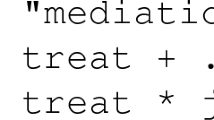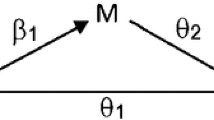Abstract
We consider mediated effects of an exposure, X on an outcome, Y, via a mediator, M, under no unmeasured confounding assumptions in the setting where models for the conditional expectation of the mediator and outcome are partially linear. We propose G-estimators for the direct and indirect effects and demonstrate consistent asymptotic normality for indirect effects when models for the conditional means of M, or X and Y are correctly specified, and for direct effects, when models for the conditional means of Y, or X and M are correct. This marks an improvement, in this particular setting, over previous ‘triple’ robust methods, which do not assume partially linear mean models. Testing of the no-mediation hypothesis is inherently problematic due to the composite nature of the test (either X has no effect on M or M no effect on Y), leading to low power when both effect sizes are small. We use generalized methods of moments (GMM) results to construct a new score testing framework, which includes as special cases the no-mediation and the no-direct-effect hypotheses. The proposed tests rely on an orthogonal estimation strategy for estimating nuisance parameters. Simulations show that the GMM-based tests perform better in terms of power and small sample performance compared with traditional tests in the partially linear setting, with drastic improvement under model misspecification. New methods are illustrated in a mediation analysis of data from the COPERS trial, a randomized trial investigating the effect of a non-pharmacological intervention of patients suffering from chronic pain. An accompanying R package implementing these methods can be found at github.com/ohines/plmed.





Similar content being viewed by others
References
Alwin, D. F., & Hauser, R. M. (1975). The decomposition of effects in path analysis. American Sociological Review, 40(1), 37.
Aroian, L. A. (1947). The probability function of the product of two normally distributed variables. The Annals of Mathematical Statistics, 18(2), 265–271.
Avagyan, V., & Vansteelandt, S. (2017). Honest data-adaptive inference for the average treatment effect under model misspecification using penalised bias-reduced double-robust estimation. arXiv:1708.03787. Forthcoming in Biostatistics and Epidemiology.
Baron, R. M., & Kenny, D. A. (1986). The moderator mediator variable distinction in social psychological research: Conceptual, strategic, and statistical considerations. Journal of Personality and Social Psychology, 51(6), 1173–1182.
Chernozhukov, V., Chetverikov, D., Demirer, M., Duflo, E., Hansen, C., & Newey, W. (2017). Double/debiased/neyman machine learning of treatment effects. American Economic Review, 107(5), 261–265.
Drton, M., & Xiao, H. (2016). Wald tests of singular hypotheses. Bernoulli, 22(1), 38–59.
Dufour, J.-M., Renault, E., & Zinde-Walsh, V. (2013). Wald tests when restrictions are locally singular. arXiv:1312.0569.
Dufour, J. M., Trognon, A., & Tuvaandorj, P. (2017). Invariant tests based on M-estimators, estimating functions, and the generalized method of moments. Econometric Reviews, 36(1–3), 182–204.
Dukes, O. & Vansteelandt, S. (2019). Uniformly valid confidence intervals for conditional treatment effects in misspecified high-dimensional models. arXiv:1903.10199.
Fritz, M. S., Taylor, A. B., & MacKinnon, D. P. (2012). Explanation of two anomalous results in statistical mediation analysis. Multivariate Behavioral Research, 47(1), 61–87.
Giersbergen, N. (2014). Inference about the indirect effect: a likelihood approach. UvA-Econometrics Working Papers 14-10, Universiteit van Amsterdam, Dept. of Econometrics.
Glonek, G. F. V. (1993). On the behaviour of wald statistics for the disjunction of two regular hypotheses. Journal of the Royal Statistical Society. Series B (Methodological), 55(3), 749–755.
Hansen, L. P. (1982). Large sample properties of generalized method of moments estimators. Econometrica, 50(4), 1029.
Hayes, A. F. (2018). Introduction to mediation, moderation, and conditional process analysis: a regression-based approach. Guilford Press, New York, NY, 2 edition.
Imai, K., Keele, L., & Tingley, D. (2010a). A general approach to causal mediation analysis. Psychological Methods, 15(4), 309–334.
Imai, K., Keele, L., & Yamamoto, T. (2010b). Identification, inference and sensitivity analysis for causal mediation effects. Statistical Science, 25(1), 51–71.
Kang, J. D., & Schafer, J. L. (2007). Demystifying double robustness: A comparison of alternative strategies for estimating a population mean from incomplete data. Statistical Science, 22(4), 523–539.
Kennedy, E. H. (2015). Semiparametric theory and empirical processes in causal inference. arXiv:1510.04740.
Kenny, D. A., & Judd, C. M. (2014). Power anomalies in testing mediation. Psychological Science, 25(2), 334–339.
MacKinnon, D. P. (2008). Introduction to statistical mediation analysis. Multivariate applications series. New York, NY: Taylor & Francis Group/Lawrence Erlbaum Associates.
MacKinnon, D. P., Lockwood, C. M., Hoffman, J. M., West, S. G., & Sheets, V. (2002). A comparison of methods to test mediation and other intervening variable effects. Psychological Methods, 7(1), 83–104.
Naimi, A. I., Cole, S. R., & Kennedy, E. H. (2017). An introduction to G methods. International Journal of Epidemiology, 46(2), 756–762.
Newey, W. K., & West, K. D. (1987). Hypothesis testing with efficient method of moments estimation. International Economic Review, 28(3), 777.
Neyman, J. (1959). Optimal asymptotic tests of composite statistical hypotheses. In U. Grenander (Ed.), Probability and Statistics: The Harald Cramer Volume (pp. 213–234). Stockholm: Almqvist and Wiskell.
Pearl, J. (2001). Direct and Indirect Effects. In Proceedings of 17th conference on uncertainy in articial intelligence, pp. 411–420. San Francisco. Morgan Kaufmann.
Robins, J. M. (1994). Correcting for non-compliance in randomized trials using structural nested mean models. Communications in Statistics - Theory and Methods, 23(8), 2379–2412.
Robins, J. M., & Greenland, S. (1992). Identifiability and exchangeability for direct and indirect effects. Epidemiology, 3(2), 143–155.
Rotnitzky, A., Lei, Q., Sued, M., & Robins, J. M. (2012). Improved double-robust estimation in missing data and causal inference models. Biometrika, 99(2), 439–456.
Rotnitzky, A., Li, L., & Li, X. (2010). A note on overadjustment in inverse probability weighted estimation. Biometrika, 97(4), 997–1001.
Rotnitzky, A., & Vansteelandt, S. (2014). Double-robust methods. In G. Molenberghs, G. Fitzmaurice, M. Kenward, A. Tsiatis, & G. Verbeke (Eds.), Handbook of missing data methodology, chapter 9 (pp. 185–212). New York: CRC Press.
Sobel, M. E. (1982). Asymptotic confidence intervals for indirect effects in structural equation models. Sociological Methodology, 13(1982), 290.
Taylor, S. J., Carnes, D., Homer, K., Pincus, T., Kahan, B. C., Hounsome, N., et al. (2016). Improving the self-management of chronic pain: COping with persistent pain, effectiveness research in self-management (COPERS). Programme Grants for Applied Research, 4(14), 1–440.
Tchetgen Tchetgen, E. J., & Shpitser, I. (2012). Semiparametric theory for causal mediation analysis: Efficiency bounds, multiple robustness and sensitivity analysis. Annals of Statistics, 40(3), 1816–1845.
Tchetgen Tchetgen, E. J., & Shpitser, I. (2014). Estimation of a semiparametric natural direct effect model incorporating baseline covariates. Biometrika, 101(4), 849–864.
Tsiatis, A. A. (2006). Semiparametric theory and missing data. New York: Springer Series in Statistics, Springer.
van Garderen, K. J., & van Giersbergen, N. (2019). Almost Similar Tests for Mediation Effects Hypotheses with Singularities. arXiv:2012.11342.
VanderWeele, T. J., & Vansteelandt, S. (2009). Conceptual issues concerning mediation, interventions and composition. Statistics and Its Interface, 2(4), 457–468.
Vansteelandt, S. (2012). Understanding counterfactual-based mediation analysis approaches and their differences. Epidemiology, 23(6), 889–891.
Vansteelandt, S., & Joffe, M. (2014). Structural nested models and g-estimation: The partially realized promise. Statistical Science, 29(4), 707–731.
Vermeulen, K., & Vansteelandt, S. (2015). Bias-reduced doubly robust estimation. Journal of the American Statistical Association, 110(511), 1024–1036.
Wang, K. (2018). Understanding power anomalies in mediation analysis. Psychometrika, 83(2), 387–406.
Author information
Authors and Affiliations
Corresponding author
Additional information
Publisher's Note
Springer Nature remains neutral with regard to jurisdictional claims in published maps and institutional affiliations.
Supplementary Information
Below is the link to the electronic supplementary material.
Rights and permissions
About this article
Cite this article
Hines, O., Vansteelandt, S. & Diaz-Ordaz, K. Robust Inference for Mediated Effects in Partially Linear Models. Psychometrika 86, 595–618 (2021). https://doi.org/10.1007/s11336-021-09768-z
Received:
Revised:
Accepted:
Published:
Issue Date:
DOI: https://doi.org/10.1007/s11336-021-09768-z




